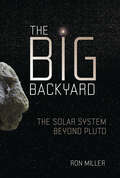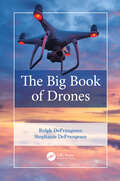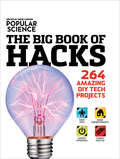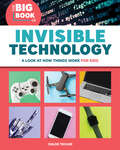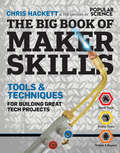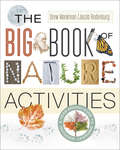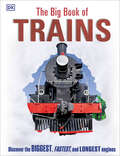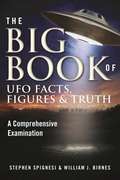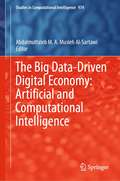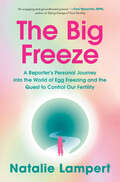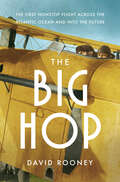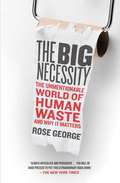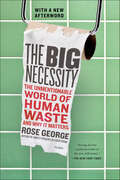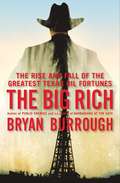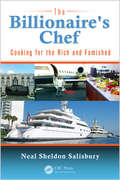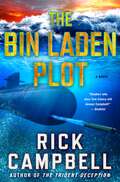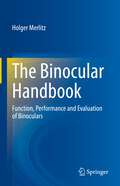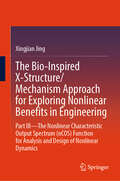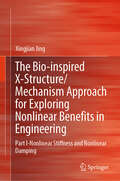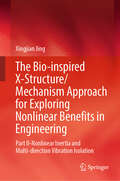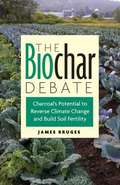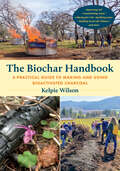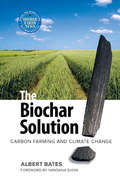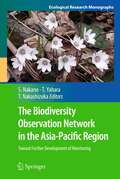- Table View
- List View
The Bias of Communication
by Alexander John Watson Harold A. InnisOne of the most influential books ever published in Canada, Harold A. Innis's The Bias of Communication has played a major part in reshaping our understanding of history, communication, and media theory. First published in 1951, this masterful collection of essays explores the relationship between a society's communication media and that community's ability to maintain control over its development. Innis considers political and economic forces in the context of social change and the role of communication in the creation of both ancient and modern empires. In an essay for this new edition, Innis biographer Alexander John Watson examines the reasons why Innis, at the height of his success as an economic historian, embarked on new research areas of communications and empire, as well as the ways in which Marshall McLuhan's interpretations of Innis changed and de-politicized Innis's work. As important today as it was when first published, The Bias of Communication is essential reading for historians and scholars of communication and media studies.
The Big Backyard: The Solar System beyond Pluto
by Ron MillerThousands of years ago, humans believed that Earth was the center of the universe, that the world they lived on was all there was. Truthfully, the solar system extends almost halfway to the nearest star. And it is composed of not only planets, asteroids, and comets, but also powerful forces and vast fields of energy. This is our solar system’s big backyard. The cold, dark world that lies at the farthest reaches of our solar system holds a vast collection of secrets, and for most of human history, we had no idea anything was out there. But, driven by curiosity and equipped with new technology, astronomers have determined that beyond the orbit of Neptune are countless icy comets, strange particles that dance under the influence of the sun, and signs of undiscovered planets. To learn more about these far-flung objects, scientists have finally begun to explore the distant solar system, finding answers to age-old questions at the same time that they encounter new mysteries. With Ron Miller’s incredible illustrations and photographs from NASA probes and telescopes, The Big Backyard takes us on a tour through the solar system’s most obscure neighborhoods and into its darkest corners, to places beyond the limits of the human eye. Miller expertly describes the formation of the solar system and the history of the exploration of the outer solar system before delving into the latest discoveries and missions. Read on to learn what sorts of objects orbit at such extreme distances, what happens at the boundary between the sun’s influence and interstellar space, whether there is such a thing as the mysterious Planet X, and how life on Earth could not exist without the happenings at the edge of the solar system.
The Big Book of Drones
by Ralph DeFrangesco Stephanie DeFrangescoDrones are taking the world by storm. The technology and laws governing them change faster than we can keep up with. The Big Book of Drones covers everything from drone law to laws on privacy, discussing the history and evolution of drones to where we are today. If you are new to piloting, it also covers how to fly a drone including a pre-flight checklist. For those who are interested in taking drones to the next level, we discuss how to build your own using a 3D printer as well as many challenging projects for your drone. For the truly advanced, The Big Book of Drones discusses how to hack a drone. This includes how to perform a replay attack, denial of service attack, and how to detect a drone and take it down. Finally, the book also covers drone forensics. This is a new field of study, but one that is steadily growing and will be an essential area of inquiry as drones become more prevalent.
The Big Book of Hacks: 264 Amazing DIY Tech Projects (Popular Science)
by Doug CantorIngenious (and hilarious) projects that aspiring makers will love, brought to you by the tinkerers at Popular Science magazine. From useful, doable gadgets to outlandish contraptions that you&’d likely be wise to avoid, this showcase of ingenuity is an entertaining tribute to the inventive spirit. In this book from the science and technology magazine that&’s been inspiring everyday people for nearly 150 years, you&’ll discover: Geek Toys: Be the life of any party with rad gaming hacks, amazing pyrotechnics, quirky DIY robots, wow-inducing projectiles, and lots of ways to make beer even better. Home Improvements: Pimp out your pad with a laser-security system, an improvised sous-vide cooker, and a life-sized cardboard display of anyone you want. Gadget Upgrades: Want to stash a flash drive in an old cassette? Use a DIY stylus on a touchscreen? Improvise a fisheye lens for your camera? With this book, you can. Things That Go: Give your motorbike a Tron vibe, deck out your car with an action-figure hood ornament, and keep gadgets charged on the go with a solar-powered backpack. …and much more!
The Big Book of Invisible Technology: A Look At How Things Work For Kids
by Chloe TaylorLearn to see how modern technology is all around us—a hands-on approach for kids 8 to 12 Bluetooth brings beautiful music to your ears—but how, exactly? Using technology and building with technology are two different skill sets—and a twenty-first-century kid will need to understand both. The Big Book of Invisible Technology offers ways to explore how things work for kids in fun, hands-on ways. From the invisible Internet to driverless cars and drones, this book shows you how things work for kids, using step-by-step experiments. Then apply your knowledge and learn how you may, one day, bring real and important change to our lives. Are you ready to solve some of Earth's biggest challenges with technology? The future needs you. In this book on how things work for kids you'll discover: Talk like a pro—Important tech-related words are highlighted in bold along with their definitions, in a virtual dictionary of how things work for kids. Hands-on—Nine applied experiments will inspire you to learn while doing—like taking apart and safely rebuilding an old keyboard or remote control. Think bigger—Discover how to brainstorm as you plan ways to positively influence our planet. Take a step toward being the next great scientist, engineer, or tech genius when you learn how things work for kids.
The Big Book of Maker Skills: Tools & Techniques for Building Great Tech Projects
by The Editors of Popular Science Chris HackettThis ultimate guide for tech makers covers everything from hand tools to robots plus essential techniques for completing almost any DIY project. Makers, get ready: This is your must-have guide to taking your DIY projects to the next level. Legendary fabricator and alternative engineer Chris Hackett teams up with the editors of Popular Science to offer detailed instruction on everything from basic wood- and metalworking skills to 3D printing and laser-cutting wizardry. Hackett also explains the entrepreneurial and crowd-sourcing tactics needed to transform your back-of-the-envelope idea into a gleaming finished product. In The Big Book of Maker Skills, readers learn tried-and-true techniques from the shop classes of yore—how to use a metal lathe, or pick the perfect drill bit or saw—and get introduced to a whole new world of modern manufacturing technologies, like using CAD software, printing circuits, and more. Step-by-step illustrations, helpful diagrams, and exceptional photography make this book an easy-to-follow guide to getting your project done.
The Big Book of Nature Activities: A Year-Round Guide to Outdoor Learning
by Jacob Rodenburg Drew MonkmanThe average child can identify over one thousand corporate logos, but only ten native plants or animals--a telling indictment of our modern disconnection from nature. Soaring levels of obesity, high rates of ADHD, feelings of stress and social awkwardness, and "Nature Deficit Disorder" are further unintended consequences of a childhood spent primarily indoors.The Big Book of Nature Activities is a comprehensive guide for parents and educators to help youth of all ages explore, appreciate and connect with the natural world. This rich, fully illustrated compendium features: Nature-based skills and activities such as species identification, photography, journaling, and the judicious use of digital technology Ideas, games, and activities grounded in what's happening in nature each season Core concepts that promote environmental literacy, such as climate change and the mechanisms and wonder of evolution, explained using a child-friendly, engaging approach Lists of key species and happenings to observe throughout the year across most of North AmericaPerfect for families, educators, and youth leaders , The Big Book of Nature Activities is packed with crafts, stories, information and inspiration to make outdoor learning fun.Jacob Rodenburg is the Executive Director of the Camp Kawartha summer camp and outdoor education centre. As well as publishing numerous articles on children, nature and the environment, he has worked in the field of outdoor education for twenty-five years.Drew Monkman is an award-winning environmental advocate, naturalist, and retired teacher. In addition to his weekly nature column, Drew is the author of two season-based nature guides, including Nature's Year.
The Big Book of Trains (DK Big Books)
by DKFrom the first locomotive built in 1804 to the high-speed bullet train, The Big Book of Trains is the perfect book for kids who love trains.Packed with amazing facts and photographs of trains around the world, The Big Book of Trains covers the history of trains and train travel. Different types of trains are featured on their own spreads, and each page features multiple images to give a close-up view as well as informative text about each train. See the differences among monorails, passenger trains, and TGVs. Learn about pistons, fireboxes, boilers, and coupling rods, and find out exactly what they do to help the train travel down on the tracks.See key features of each train model and discover the difference between steam trains and diesels. Find out how trains are designed for certain jobs and tasks, including mountain trains, snow trains, and freight trains. Look at the biggest and fastest trains in the world.With incredible pictures and informative text, The Big Book of Trains is the essential book for young readers who want to know everything about trains.
The Big Book of UFO Facts, Figures & Truth: A Comprehensive Examination
by William J. Birnes Stephen SpignesiIn a mothership full of entertaining and informative chapters, authors Stephen Spignesi and William Birnes, writers of many books dealing with the intriguing, weird, and unexplained, shed a revealing beam of light on the UFO phenomenon. From inexplicable cattle mutilations and modern astronauts who have seen UFOs, to close encounters of the third and fourth kind, and, it’s all here: The latest on Roswell, and the 1947 crash that has never been explainedThe weirdest (and most convincing) alien abductions—and the medical procedures performed on abducteesThe most commonly-seen UFO shapesA who's who of UFOlogy—including presidents that have seen UFOsUFOs and the Bible20 years of Project Blue Book mysteries—NASA’s official UFO investigationWeirdness galore—Men in Black, crop circles, Bigfoot, the face on Mars, Hollow Earth Theory, alien ancestry, and more!The Big Book of UFO Facts, Figures & Truth is at once a valuable reference and an engrossing guide for all those fascinated with unexplained phenomenon. Turning to any page at random, readers are sure to find new facts and information, as well as dozens of rare, irrefutable photos. In addition, readers will learn how they can access a special website which includes actual video evidence of UFOs. This just may be the most comprehensive UFO guide available.
The Big Data-Driven Digital Economy: Artificial and Computational Intelligence (Studies in Computational Intelligence #974)
by Abdalmuttaleb M. A. Musleh Al-SartawiThis book shows digital economy has become one of the most sought out solutions to sustainable development and economic growth of nations. This book discusses the implications of both artificial intelligence and computational intelligence in the digital economy providing a holistic view on AI education, economics, finance, sustainability, ethics, governance, cybersecurity, blockchain, and knowledge management. Unlike other books, this book brings together two important areas, intelligence systems and big data in the digital economy, with special attention given to the opportunities, challenges, for education, business growth, and economic progression of nations. The chapters hereby focus on how societies can take advantage and manage data, as well as the limitations they face due to the complexity of resources in the form of digital data and the intelligence which will support economists, financial managers, engineers, ICT specialists, digital managers, data managers, policymakers, regulators, researchers, academics, students, economic development strategies, and the efforts made by the UN towards achieving their sustainability goals.
The Big Freeze: A Reporter's Personal Journey into the World of Egg Freezing and the Quest to Control Our Fertility
by Natalie LampertA fascinating investigation into the lucrative, minimally regulated, fast-growing industry of egg freezing, from a young reporter on a personal journey into the world of cutting-edge reproductive medicine&“An engaging and groundbreaking book.&”—Toni Weschler, MPH, author of Taking Charge of Your FertilityOvaries. Most women have two; journalist Natalie Lampert has only one. Then, in her early twenties, she almost lost it, along with her ability to ever have biological children. Doctors urged her to freeze her eggs, and Lampert started asking questions. The Big Freeze is the story of Lampert&’s personal quest to investigate egg freezing, as well as the multibillion-dollar femtech industry, in order to decide the best way to preserve her own fertility. She attended flashy egg-freezing parties, visited high-priced fertility clinics, talked to dozens of women who froze their eggs, toured the facility in Italy where the technology was developed, and even attended a memorial service for thousands of accidentally destroyed embryos. What was once science fiction is now simply science: Fertility can be frozen in time. Between 2009 and 2022, more than 100,000 women in the United States opted to freeze their eggs. Along with in vitro fertilization, egg freezing is touted as a way for women to &“have it all&” by conquering their biological clocks, in line with the global trend of delaying childbirth. A generation after the Pill, this revolutionary technology offers a new kind of freedom for women. But does egg freezing give women real agency or just the illusion of it?A personal and deeply researched guide to the pros, cons, and many facets of this wildly popular technology, The Big Freeze is a page-turning exploration of the quest to control fertility, with invaluable information that answers the questions women have been afraid to ask—or didn&’t know they should ask in the first place.
The Big Hop: The First Non-stop Flight Across the Atlantic Ocean and Into the Future
by David RooneyThe inspiring story of a pathbreaking 1919 flight and the courageous fliers who risked their lives to make aviation history. In 1919, in Newfoundland, four teams of aviators came from Britain to compete in “the Big Hop”: an audacious race to be the first to fly, nonstop, across the Atlantic Ocean. One pair of competitors was forced to abandon the journey halfway, and two pairs never made it into the air. Only one team, after a death-defying sixteen-hour flight, made it to Ireland. Celebrated on both continents, the transatlantic contest offered a surge of inspiration—and a welcome distraction—to a public reeling from the Great War and the influenza pandemic. But the seven airmen who made the attempt were quickly forgotten, their achievement overshadowed by the solo Atlantic flights of Charles Lindbergh and Amelia Earhart years later. In The Big Hop, David Rooney grants the pioneering aviators of 1919 the spotlight they deserve. From Harry Hawker, the pilot who as a young man had watched Houdini fly over his native Australia, to the engineer Ted Brown, a US citizen who joined the Royal Flying Corps, Rooney traces the lives of the unassuming men who performed extraordinary acts in the sky. Mining evocative first-person accounts and aviation archives, Rooney also follows the participants’ journeys: learning to fly on flimsy airplanes made of timber struts and varnished fabric; surviving the bloodiest war that Europe had ever yet seen; and battling faulty coolant systems, severe storms, and extreme fatigue while attempting the Atlantic. Rooney transports readers to the world in which the great contest took place, and traces the rise of aviation to its daredevil peak in the early decades of the twentieth century. Recounting a deeply moving adventure, The Big Hop explores why flights like these matter, and why we take to the skies.
The Big Necessity: The Unmentionable World of Human Waste and Why It Matters
by Rose GeorgeDelving deep into the history and implications of a daily act that dare not speak its name, The Big Necessity is on its way to removing the taboo on bodily waste something common to all and as natural as breathing.
The Big Necessity: The Unmentionable World of Human Waste and Why It Matters
by Rose GeorgeAn “extraordinary” look at the stubborn problem of human waste disposal: “Among the best nonfiction books of the new millennium.” —The New York TimesAcclaimed as “valuable and often entertaining” (Los Angeles Times), The Big Necessity defies the taboo on bodily waste—something common to all and as natural as breathing. We prefer not to talk about it, but we should—even those of us who take care of our business in pristine, sanitary conditions. Disease spread by waste kills more people worldwide every year than any other single cause of death. Even in America, nearly two million people have no access to an indoor toilet. Yet the subject remains unmentionable.Moving from the underground sewers of Paris, London, and New York (an infrastructure disaster waiting to happen) to an Indian slum where ten toilets are shared by 60,000 people, The Big Necessity breaks the silence, revealing everything that matters about how people do—and don’t—deal with their own waste. With razor-sharp wit and crusading urgency, mixing levity with gravity, Rose George has turned the subject we like to avoid into a cause with the most serious of consequences.“One smart book . . . delving deep into the history and implications of a daily act that dare not speak its name.” —Newsweek“Makes a passionate argument for putting sanitation at the top of the world’s development agenda.” —Time“With irreverence and pungent detail, George breaks the embarrassed silence over the economic, political, social and environmental problems of human waste disposal. Full of fascinating facts . . . an intrepid, erudite and entertaining journey through the public consequences of this most private behavior.” —Publishers Weekly (starred review)
The Big Rich: The Rise and Fall of the Greatest Texas Oil Fortunes
by Bryan BurroughIn The Big Rich, bestselling author and Vanity Fair special correspondent Bryan Burrough chronicles the rise and fall of one of the great economic and political powerhouses of the twentieth century: Texas oil. By weaving together the epic sagas of the industry's four greatest fortunes, Burrough has produced an enthralling tale of money, family, and power in the American century. Known in their day as the Big Four, Roy Cullen, H. L. Hunt, Clint Murchison, and Sid Richardson were all from modest backgrounds, and all became patriarchs of the wealthiest oil families in Texas. As a class they came to be known as the Big Rich, and together they created a new legend in America, the swaggering Texas oilman who owns private islands, sprawling ranches and perhaps a football team or two, and mingles with presidents and Hollywood stars. The truth more than lives up to the myth. Along with their peers, the Big Four shifted wealth and power in America away from the East Coast, sending three of their state's native sons to the White House and largely bank rolling the rise of modern conservatism in America. H. L. Hunt became America's richest man by grabbing Texas's largest oilfield out from under the nose of the man who found it; he was also a lifelong bigamist. Clint Murchison entertained British royalty on his Mexican hacienda and bet on racehorses and conducted dirty deals with J. Edgar Hoover. Roy Cullen, an elementary school dropout, used his millions to revive the hapless Texas GOP. And Sid Richardson, the Big Four's fun-loving bachelor, was a friend of several presidents, including, most fatefully, Lyndon Johnson. The Big Four produced offspring who frequently made more headlines, and in some cases more millions, than they did. With few exceptions, however, their fortunes came to an end in a swirl of bitter family feuds, scandals, and bankruptcies, and by the late 1980s, the era of the Big Rich was over. But as Texas native Bryan Burrough reveals in this hugely entertaining account, the profound economic, political, and cultural influence of Texas oil is still keenly felt today. Included are chapter notes, citations, bibliographic notes, and index. Bookshare Note: For the most part written factually, the author's personal bias often shows through, sometimes subtly and other times blatantly.
The Billionaire's Chef: Cooking for the Rich and Famished
by Neal SalisburyA Wonka-Like Journey into an Ultra Private World of Decadence and ExcessFrom cooking for Martha Stewart, SeanPuff Daddy Combs, and Jerry Seinfeld to more than 20 of the world's most reclusive billionaires, Chef Neal Sheldon Salisbury has been serving the world's power elite for more than 15 years. His new book, The Billionaire's Chef: Cooking fo
The Bin Laden Plot: A Novel (Trident Deception Series #7)
by Rick CampbellA U.S. destroyer is torpedoed by an Iranian submarine and Captain Murray Wilson of the U.S.S. Michigan is flown to the Pentagon to meet with the Secretary of the Navy (SecNav). There Wilson learns that the Iranian submarine is just a cover story. One of the United States' own fully automated unmanned underwater vehicles has gone rogue, its programming corrupted in some way. Murray is charged with hunting it down and taking it out before the virus that's infected its operating system can infect the rest of the fleet. At the same time, the head of the SEAL detachment aboard the U.S.S Michigan is killed and Lonnie Mixell, a former U.S. operative, now assassin for hire, is responsible. And that is only the first SEAL to be hunted down and killed. Jake Harrison, fellow SEAL, discovers that these SEALs had one mission in common - they were all on the team that killed Bin Laden. Or so the world was told. As Wilson discovers that his mission is actually meant to cover up dangerous acts of corruption, even treason, Harrison discovers that the assassin is out to protect the same forces. Forces too powerful for either of them to take on alone.
The Binocular Handbook: Function, Performance and Evaluation of Binoculars
by Holger MerlitzThis book is a comprehensive technical treatise on binoculars as visual optical instruments. The author begins by discussing the function of binoculars and the properties of human visual perception. Theoretical models for the synthesis of binoculars and the complex interplay of the different components of binoculars are described. Subsequently, the performance limits, as experienced by the observer in a variety of external conditions, are derived. In the concluding section, the book takes the reader outdoors, where they learn to evaluate the properties and limitations of their binoculars in the field, and to recognize possible problems that may be due to manufacturing errors or accidental damages. Thus, a level of knowledge is provided that will enable the reader to fully exploit the capacities of their binoculars. This book is written for those who work professionally with binoculars and are technically interested, but it is equally useful for professional staff working in the optical industry and the distribution of optical instruments. It includes recent discoveries and is easily accessible to anyone who is seriously interested in learning about binocular function. High school level math is useful to understand the derivations, but not needed to comprehend the results, which are discussed and displayed graphically.
The Bio-Inspired X-Structure/Mechanism Approach for Exploring Nonlinear Benefits in Engineering: Part III—The Nonlinear Characteristic Output Spectrum (nCOS) Function for Analysis and Design of Nonlinear Dynamics
by Xingjian JingThis book presents a unique approach to the design and analysis of beneficial nonlinearity, which can take an important and critical role in engineering systems and thus cannot be simply ignored in structural design, dynamic response analysis, and parameter selection. A key issue in the area is thus systematically addressed about how to analyze and design potential nonlinearities introduced to or inherent in a system of under study, which is a must-do task in many practical applications involving vibration control, energy harvesting, sensor systems and robots etc. This book, together with several other books in this book series, is to present an up-to-date summary on the most recent development of a cutting-edge method for nonlinearity manipulation and employment developed in recent several years, named as the X-shaped structure or mechanism approach. The X-shaped structure or mechanism is a generic structure or mechanism representing a class of beneficial geometric nonlinearity with realizable and flexible linkage mechanism or structural design of different variants or forms (quadrilateral, diamond, polygon, K/Z/S/V-shape, or others) which all share similar geometric nonlinearity and thus similar nonlinear stiffness/damping properties, flexible in design, and easy to implement. This book is particularly to present a systematic frequency domain analysis, design and optimization method of critical structural or control parameters in nonlinear systems including the X-structure/mechanism dynamics, aiming at better dynamic performance and special nonlinear response as expected in engineering practice. Cases studies in vehicle suspension, energy harvesting, fault detection and fuzzy membership optimization are all showcased. The new analysis and design method introduced in this book definitely present a totally new and powerful approach to optimization and understanding of a class of nonlinear systems from a special frequency domain point of view.
The Bio-inspired X-Structure/Mechanism Approach for Exploring Nonlinear Benefits in Engineering: Part I-Nonlinear Stiffness and Nonlinear Damping
by Xingjian JingThis book presents a unique approach to the design and analysis of beneficial nonlinearity, which can take an important and critical role in engineering systems and thus cannot be simply ignored in structural design, dynamic response analysis, and parameter selection. A key issue in the area is thus systematically addressed about how to analyze and design potential nonlinearities introduced to or inherent in a system, which is a must-do task in many practical applications involving vibration control, energy harvesting, sensor systems and robots, etc. This book, therefore, presents an up-to-date summary on the most recent development of a cutting-edge method for nonlinearity manipulation and employment developed in recent several years, known as the X-shaped structure or mechanism approach. The method is inspired from animal leg/limb skeletons and can provide passive low-cost high-efficiency adjustable and beneficial nonlinear stiffness (high static and ultra-low dynamic), nonlinear damping (dependent on resonant frequency and vibration excitation amplitude), and nonlinear inertia (low static and high dynamic) individually or simultaneously. The X-shaped structure or mechanism is a generic structure or mechanism representing a class of beneficial geometric nonlinearity with realizable and flexible linkage mechanism or structural design of different variants or forms (quadrilateral, diamond, polygon, K/Z/S/V/A/W-shape, or others) which all share similar geometric nonlinearity and thus similar nonlinear stiffness/damping properties, flexible in design, and easy to implement. This book systematically introduces the research background, motivation, essential bio-inspired ideas, advantages of this novel method, beneficial nonlinear properties in stiffness, damping and inertia, associated theory for analysis and design of nonlinear dynamics, potential applications and case studies, most of which have been developed ever since 2010. This is Part I of this book series, and the results in this book focus on beneficial nonlinear stiffness and damping characteristics of the fundamental X-shaped structure/mechanism and its variants, and provide an in-depth understanding of potential nonlinear properties that can be achieved through passive structural/mechanism designs via this class of X-structures or mechanisms.
The Bio-inspired X-Structure/Mechanism Approach for Exploring Nonlinear Benefits in Engineering: Part II-Nonlinear Inertia and Multi-direction Vibration Isolation
by Xingjian JingThis book presents a unique approach to the design and analysis of beneficial nonlinearity, which can take an important and critical role in engineering systems and thus cannot be simply ignored in structural design, dynamic response analysis, and parameter selection. A key issue in the area is thus systematically addressed about how to analyze and design potential nonlinearities introduced to or inherent in a system of under study, which is a must-do task in many practical applications involving vibration control, energy harvesting, sensor systems and robots, etc. This book, therefore, presents an up-to-date summary on the most recent development of a cutting-edge method for nonlinearity manipulation and employment developed in recent several years, named as the X-shaped structure or mechanism approach. The method is inspired from animal leg/limb skeletons and can provide passive low-cost high-efficiency adjustable and beneficial nonlinear stiffness (high static and ultra-low dynamic), nonlinear damping (dependent on resonant frequency and vibration excitation amplitude) and nonlinear inertia (low static and high dynamic) individually or simultaneously. The X-shaped structure or mechanism is a generic structure or mechanism representing a class of beneficial geometric nonlinearity with realizable and flexible linkage mechanism or structural design of different variants or forms (quadrilateral, diamond, polygon, K/Z/S/V-shape, or others) which all share similar geometric nonlinearity and thus similar nonlinear stiffness/damping properties, flexible in design, and easy to implement. This book systematically reviews the research background, motivation, essential bio-inspired ideas, advantages of this novel method, beneficial nonlinear properties in stiffness, damping and inertia, and potential applications, which have been developed ever since 2010. This book reveals important nonlinear properties and dynamic characteristics of nonlinear inertia that can be provided through the X-structure/mechanism and also presents advantageous features of X-structure/mechanism methods in multi-direction vibration control.
The Biochar Debate
by James BrugesThe Biochar Debateis the first book to introduce both the promise and concerns surrounding biochar (fine-grained charcoal used as a soil supplement) to nonspecialists. Charcoal making is an ancient technology. Recent discoveries suggest it may have a surprising role to play in combating global warming. This is because creating and burying biochar removes carbon dioxide from the atmosphere. Furthermore, adding biochar to soil can increase the yield of food crops and the ability of soil to retain moisture, reducing need for synthetic fertilizers and demands on scarce fresh-water supplies. While explaining the excitement of biochar proponents, Bruges also gives voice to critics who argue that opening biochar production and use to global carbon-credit trading schemes could have disastrous outcomes, especially for the world's poorest people. The solution, Bruges explains, is to promote biochar through an alternative approach called the Carbon Maintenance Fee that avoids the dangers. This would establish positive incentives for businesses, farmers, and individuals to responsibly adopt biochar without threatening poor communities with displacement by foreign investors seeking to profit through seizure of cheap land. The Biochar Debatecovers the essential issues from experimental and scientific aspects of biochar in the context of global warming to fairness and efficiency in the global economy to negotiations for the future of the Kyoto Protocol.
The Biochar Handbook: A Practical Guide to Making and Using Bioactivated Charcoal
by Kelpie WilsonWith extensive research, real-world examples, and hands-on applications, this go-to guide offers a comprehensive look at the principles and practices of biochar—and all of its world-changing uses.Like many human discoveries, biochar has likely been invented, lost, and reinvented multiple times. It can be found in the rich terra preta soils of the Amazon and in the ancient &“dark earths&” dotting Africa, Asia, and Europe. However, biochar isn&’t just an archeological curiosity. In The Biochar Handbook, author Kelpie Wilson argues that the simple process of burning organic material in a low-oxygen, low-emission environment could be one of the most powerful tools we have to restore degraded soils and reduce our dependence on fossil fuels.In accessible and authoritative prose, Wilson demonstrates that biochar is a low-tech but effective means of reducing wildfire risks, restoring soil carbon, managing manure, weaning farms off of toxic inputs, and producing the best compost ever made.In this book, you&’ll also find:A pocket history of biocharStep-by-step instructions on making biochar for yourselfApplications for soil water retention, pest deterrence, compost enhancement, and moreInspiring examples of ecosystem restoration and improved forest managementLow-cost recipes, including Cultured Biochar and Sustainable Potting SoilWilson makes a compelling case that biochar is both simple to make and a potent solution to a host of knotty problems, both global and close to home. Whether you&’re a gardener, homesteader, rancher, commercial farmer, permaculturalist, or forest manager, this book will show you how to put biochar to work, making you and your community more resilient as a result.
The Biochar Solution
by Albert BatesConventional agriculture destroys our soils, pollutes our water, and is a major contributor to climate change. What if our agricultural practices could stabilize, or even reverse these trends?The Biochar Solution explores the dual function of biochar as a carbon-negative energy source and a potent soil-builder. Created by burning biomass in the absence of oxygen, this material has the unique ability to hold carbon back from the atmosphere while simultaneously enhancing soil fertility. Albert Bates traces the evolution of this extraordinary substance, from the ancient black soils of the Amazon to its reappearance as a modern carbon sequestration strategy.Combining practical techniques for the production and use of biochar with an overview of the development and future of carbon farming, The Biochar Solution describes how a new agricultural revolution can reduce net greenhouse gas emissions to below zero while increasing world food reserves and creating energy from biomass wastes. Biochar and carbon farming can:*Reduce fossil fuels inputs into our food system*Bring new life to desert landscapes*Filter and purify drinking water*Help build carbon-negative homes, communities, and nationsBiochar is not without dangers if unregulated, and it is not a panacea, but if it fulfills its promise of taking us back from the brink of irreversible climate change, it may well be the most important discovery in human history.
The Biodiversity Observation Network in the Asia-Pacific Region
by Shin-Ichi Nakano Tetsukazu Yahara Tohru NakashizukaBiological diversity is important for ecosystem function and services, which in turn is essential for human well-being. Under the Convention on Biological Diversity, international efforts have been made to achieve a significant reduction in the current rate of biodiversity loss. The loss continues, however. The Asia-Pacific region includes both developing countries with high biodiversity and developed countries with sophisticated data collection and analyses, but only limited information about the status quo of biodiversity in this region has been available. Many Asia-Pacific countries have rapidly grown their economies and social infrastructures, causing a loss of biodiversity and requiring an urgent mandate to achieve a balance between development and conservation in the region. In December 2009, scientists successfully organized the Asia-Pacific Biodiversity Observation Network in the region, to establish a network for research and monitoring of ecosystems and biodiversity and to build a cooperative framework. The present volume is the first collection of information on biodiversity in the Asia-Pacific and represents a quantum step forward in science that optimizes the synergy between development and biodiversity conservation.

